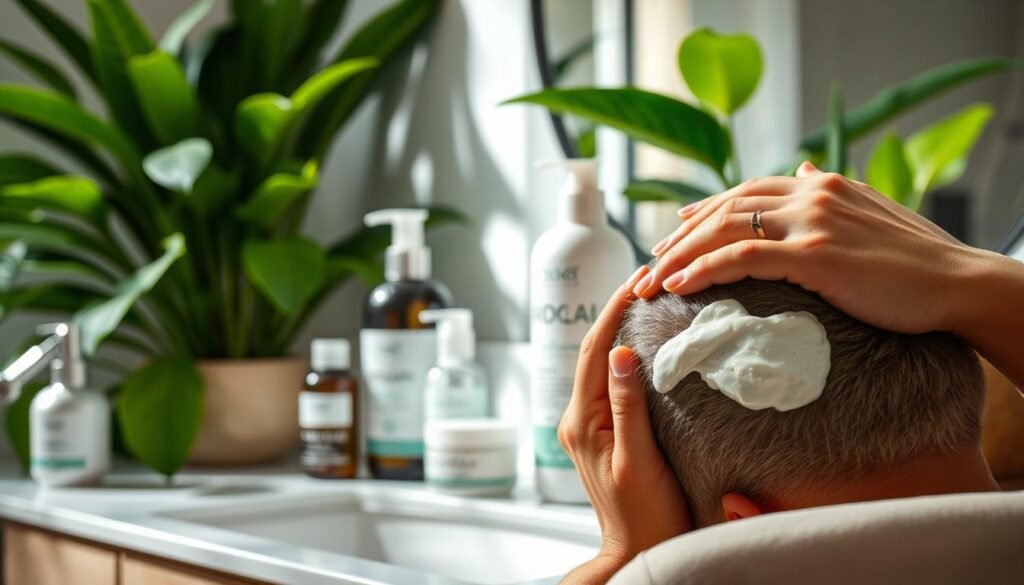About 10% of people with seborrheic dermatitis experience hair loss. This condition affects 3-5% of folks, mostly on the scalp. The link between hair loss and seborrheic dermatitis is important. It affects confidence and life quality. Knowing how they connect helps in managing hair loss due to seborrheic dermatitis.
Inflammation and skin oil imbalance can harm hair follicles. So, understanding causes and symptoms is key. This includes exploring treatments. This article will share expert tips to keep your scalp and hair healthy. It deals with seborrheic dermatitis and hair loss.
Key Takeaways
- Seborrheic dermatitis affects a significant portion of the population, often leading to hair loss.
- Proper treatment can help alleviate symptoms and support hair regrowth.
- Understanding the connection between hair loss and seborrheic dermatitis is vital for effective management.
- Regular use of medicated shampoos can show effectiveness in managing symptoms.
- Lifestyle changes may help prevent seborrheic dermatitis flare-ups.
- Expert advice is invaluable in navigating treatment options.
Understanding Seborrheic Dermatitis
Seborrheic dermatitis affects many people around the world, with about 3% to 12% getting it. It usually shows up as a flaky, itchy rash on oily skin areas like the scalp, face, and upper back. For babies under three months, it’s called cradle cap, which often goes away by the time they’re six to twelve months old.
The exact cause of seborrheic dermatitis is still not known. Yet, several factors seem to play a role. These include an overgrowth of a yeast called Malassezia and too much oil from the sebaceous glands. People with oily skin, as well as certain environmental conditions, might be more at risk.
In adults, seborrheic dermatitis usually starts in late adolescence. It’s most common among young adults and older men. About 5% of adults deal with it, especially those aged 30 to 60. Symptoms can vary, from greasy patches that flake off to scaly areas that affect the scalp.
Seborrheic dermatitis is chronic, meaning it comes and goes. Managing it well involves understanding that stress and diet can affect the symptoms. Eating lots of fruits might help reduce flare-ups.
| Statistic | Details |
|---|---|
| Total Prevalence | Affects 3% to 12% of the global population |
| Infantile Cases | Occurs under 3 months, resolves by 6-12 months |
| Adult Incidence | Begins in late adolescence, more common in males |
| Skin Type Association | 50% of individuals have oily skin |
| Common Triggers | Stress, lack of sleep, irritants, dry skin |
What Causes Hair Loss in Seborrheic Dermatitis?
Seborrheic dermatitis hair loss happens for many reasons. Increased oil makes the scalp irritated, which leads to hair falling out. This comes from inflammation that harms hair roots and makes hair shed more.
Malassezia yeast on the scalp is another big cause. Too much of this yeast, if not taken care of, leads to inflammation. This hurts the hair roots and starts a cycle of damage and hair loss.
Hair loss from seborrheic dermatitis is usually not permanent. To manage symptoms and help recovery, proper treatment is vital. You can use shampoos with zinc pyrithione or ketoconazole from the store. In tough cases, you might need prescription medicines.
Knowing the causes of hair loss from seborrheic dermatitis shows why it’s key to fight inflammation and keep the scalp healthy. Cleaning your scalp the right way regularly can reduce problems and aid in growing new hair.
Symptoms of Seborrheic Dermatitis
Spotting the signs of seborrheic dermatitis is key for quick treatment. Common signs include an itchy scalp, redness, and greasy spots with white or yellow flakes. This problem is usually found in oily parts of the body like the scalp, face, and chest. It can make people feel uncomfortable and worried.
Dandruff is often linked with seborrheic dermatitis. It appears as flaky skin on the scalp and beard area. Sometimes, flakes can also show up on the eyebrows, ears, and eyelids. Things like stress, being really tired, and changes in the weather can make symptoms worse. This is why paying attention to changes in your body is so important.
“Identifying the symptoms early can lead to effective management and improve one’s quality of life.”
The rash might look different depending on your skin color. For people with brown or Black skin, it might look darker or lighter. On white skin, it tends to be more reddish. Scratching a lot, especially near the hairline, can cause hair loss. This hair loss comes more from scratching than the skin condition itself. It shows why taking care of an itchy scalp is crucial to avoid more problems.
Dealing with it long-term might mean using special shampoos or treatments. If you keep having symptoms like itchiness and flaking, it’s a good idea to see a doctor. They can suggest a treatment plan just for you.
| Symptom | Description |
|---|---|
| Itchy Scalp | Persistent itching and irritation in the scalp region. |
| Dandruff | Flaking skin visible on the scalp and hair. |
| Redness | Inflamed skin areas, often accompanying patches. |
| Greasy Patches | Oily areas with flaky skin, particularly on the scalp and face. |
| Flaking Skin | White or yellow flakes on the body’s oily regions. |
Diagnosis of Seborrheic Dermatitis
The first step in diagnosing seborrheic dermatitis is a detailed check-up by a skin specialist. They start by looking at the patient’s symptoms and their health background. This helps them spot the disease, which has unique signs, though it can look like other skin problems, such as psoriasis.
When the symptoms are not clear, a skin biopsy might be needed. This test lets the doctor examine the skin more closely. It helps tell seborrheic dermatitis apart from other similar issues. Getting it right is key because it decides the best treatment plan for the patient.
Anyone with ongoing scalp issues should see a skin doctor soon. Catching seborrheic dermatitis early can stop worse problems later on. To learn about dealing with hair loss from various conditions, check out this resource.
| Diagnosis Step | Description |
|---|---|
| Symptom Review | Assessment of visible symptoms and medical history. |
| Physical Examination | Close examination of affected skin areas to identify dermatitis signs. |
| Skin Biopsy | A procedure to collect a small skin tissue sample for further analysis if necessary. |
| Diagnosis Confirmation | Final determination of seborrheic dermatitis versus other possible conditions. |
Treatment Options for Seborrheic Dermatitis
Seborrheic dermatitis brings challenges in finding the right treatment. There are many ways to treat the hair loss it causes. You can use medicated creams, special shampoos, and change your diet.
For tough cases, shampoos with ingredients like ketoconazole or ciclopirox can help. People 16 and older can use ciclopirox shampoo. After four weeks, 58% of users see better skin. These shampoos reduce flaking and calm inflammation.
Antifungal creams are also key. Doctors often suggest creams like pimecrolimus or ointments like tacrolimus. They reduce symptoms in two weeks. For quick relief from swelling and itchiness, creams like hydrocortisone are used daily.
If creams and shampoos don’t work, you might need pills like itraconazole or terbinafine. Your treatment plan should include medicated shampoos. How often you use them depends on your hair type. Straight or wavy hair needs it 2 to 3 times a week. Curly hair might need it just once a week.
Talking regularly with a dermatologist can make your treatment suit you better. For more details on treating seborrheic dermatitis, check out this resource.
| Treatment Method | Application Frequency | Effectiveness |
|---|---|---|
| Medicated shampoos (e.g., ketoconazole) | 2-3 times a week or weekly based on hair type | 58% improvement in clinical trials |
| Topical antifungal creams (e.g., pimecrolimus) | As directed; typically daily | Reduction in symptoms within 2 weeks |
| Corticosteroids (e.g., hydrocortisone) | 1-2 times daily | Rapid reduction of inflammation and itch |
| Oral antifungals (e.g., itraconazole) | As prescribed | Varies; effective for severe cases |
Medicated Shampoos for Scalp Care
Medicated shampoos are key for treating seborrheic dermatitis. They help with discomfort and flaking. Ingredients like zinc pyrithione, coal tar, and salicylic acid fight inflammation and support a healthy scalp.
For the best results, it’s advised to use the shampoo a few times a week. Leave it on the scalp for a few minutes to work better. Studies found a big improvement in symptoms with regular use. A 49% improvement was seen in two weeks with a zinc pyrithione shampoo. After six weeks, the improvement was 65%.

An overview of popular medicated shampoos highlights their different effectiveness:
| Shampoo | Active Ingredient | Effectiveness |
|---|---|---|
| Head & Shoulders Clinical Strength | Selenium sulfide | Effective as ketoconazole for treating seborrheic dermatitis |
| T/Sal Therapeutic Shampoo | Salicylic acid (3%) | Breaks down dead skin cells and softens scales |
| Nizoral Anti-Dandruff | Ketoconazole | Safe for use 1-2 times a week |
| Jupiter Balancing Shampoo | Herbal and zinc pyrithione | Reduces hair breakage by 30% |
Dermatologists suggest using medicated shampoos every other day. This helps manage sebum and improves symptoms. If you still have symptoms, see a healthcare professional. For more on product effectiveness, visit this resource.
Best Treatment for Seborrheic Dermatitis Hair Loss
Seborrheic dermatitis is a skin issue leading to hair loss. It’s caused by infections and heavy dandruff. To treat it, experts suggest antifungal creams, special shampoos, and corticosteroids. These treatments help with symptoms and stop further issues.
Some common over-the-counter treatments include salicylic acid or selenium sulfide. They aim to reduce scalp infection and ease symptoms. Ketoconazole, a strong antifungal, is also crucial. It works to keep hair follicles healthy, despite possible side effects like nausea.
Topical corticosteroids are used to lessen inflammation and soothe redness. They help ease the irritation from the condition. However, they can cause skin peeling or more sweating. It’s important to listen to a dermatologist when using them. Tailoring treatment plans is key since everyone reacts differently to therapies.
Starting treatment early is important. It helps avoid long-term hair problems. The condition’s oiliness often makes thinning hair worse. But, tackling inflammation and taking care of the scalp can boost hair growth.
If seborrheic dermatitis and hair loss are issues, seeing a dermatologist is wise. They can offer a treatment plan made just for you. With the right care, hair can start to grow back after the inflammation goes away. This improves hair health overall.
A lot more info on seborrheic dermatitis can be found here.
Managing Hair Loss Seborrheic Dermatitis
Managing hair loss from seborrheic dermatitis needs a strong treatment and care plan. A lot of people have this condition, with rates from 1% to 3% in the general public. And among people with weak immune systems, it’s even higher at 34% to 83%. Young men, especially those aged 20 to 30, often see hair loss from this condition.
Treating scalp inflammation starts with following a doctor’s advice. This might include using special shampoos like ketoconazole. These can be used from once a day to twice a week. It helps keep the scalp healthy and can promote hair growth.

Adding daily habits can also help. Try gentle scalp massages to boost blood flow and support follicle health. Choosing mild hair products can also lessen irritation. It’s important to watch how your scalp reacts and adjust your routine as needed.
Taking a whole-body approach to hair care makes a big difference. By using the right treatments and being smart about lifestyle choices, people can lessen the impact of this tough condition. This helps maintain strong, healthy hair growth in the long run.
Lifestyle Changes to Prevent Flare-Ups
Making lifestyle changes can greatly help in dealing with seborrheic dermatitis and avoiding hair loss it causes. By adopting some easy strategies, you can better care for your scalp. This helps keep flare-ups at bay. Here are some good changes to make:
- Reduce Stress: Stress can make symptoms worse. Adding relaxation methods like meditation and yoga helps a lot.
- Balanced Diet: Eating foods full of vitamins and minerals boosts your immune system and may help ease symptoms.
- Scalp Hygiene: A soft approach to scalp care, with regular washes and no rough scrubbing, keeps it clean and less irritated.
- Avoid Alcohol Products: Hair products with alcohol can trigger more flare-ups. It’s better to use products without harmful chemicals for a healthier scalp.
- Regular Shampoo Use: Using medicated shampoos with zinc pyrithione or ketoconazole helps, especially during flare-ups.
These proactive steps can significantly improve your scalp’s health and reduce the risk of hair loss. Paying attention to these changes can really make a difference in managing seborrheic dermatitis.
Home Remedies for Seborrheic Dermatitis and Hair Health
Home remedies are great support with usual seborrheic dermatitis treatments. Natural methods can ease symptoms and keep hair healthy. Using coconut oil or aloe vera helps lessen inflammation and nourish the scalp.
Washing the scalp with gentle shampoos can also help. It reduces flaking and oiliness, which is good for hair health. Tea tree oil is another good choice. It fights bacteria and fungus when used right.
Taking fish oil supplements can also be helpful. They might lessen symptoms for skin issues. Probiotics could boost the immune system and fight inflammation but need more study.
Remember, these home remedies should add to, not replace, medical treatments. A plan that includes natural methods can work well for those with this condition.

Alternative Therapies for Treatment
Alternative therapies can offer relief for seborrheic dermatitis symptoms. People often look for options beyond standard medicated shampoos and creams. Tea tree oil is a popular natural choice. A study found that a shampoo with 5% tea tree oil improved symptoms by 41%. This was much better than the 11% improvement with a placebo.
Other options include dietary supplements. Fish oil, which is high in omega-3 fatty acids, may help with allergy-related flare-ups. Probiotics are also considered beneficial, especially for children with dermatitis. Yet, research on seborrheic dermatitis and probiotics is still emerging.
Aloe vera extracts can be effective against this condition. Some experts suggest eating foods high in vitamins E, C, and K could help. This type of diet is anti-inflammatory and may boost immune health. Home remedies like apple cider vinegar are also used to lessen scalp scale and redness.
When trying alternative therapies, it’s vital to talk with healthcare providers. They can offer advice and help avoid any possible risks. Consulting them ensures a safe and thorough approach to managing symptoms.
Conclusion
Effectively managing hair loss from seborrheic dermatitis needs a well-rounded plan. This includes knowing the condition well, using the right treatments, and changing your lifestyle for better scalp health. If you’re losing more hair or it’s getting thinner, talking to a professional is key. Both drug treatments like finasteride and natural options like acupuncture have high success rates.
Lifestyle changes are also vital in fighting seborrheic dermatitis flare-ups. Adding a scalp care routine and understanding how hormones affect your condition can boost your health. This way, you help your hair grow healthier. Knowing your options and taking action early can make a big difference in managing hair loss.
In the end, paying continuous attention to scalp health boosts your outlook if you have this condition. With advice from experts and a focus on what works for you, you can greatly improve your hair’s health and your life’s quality..